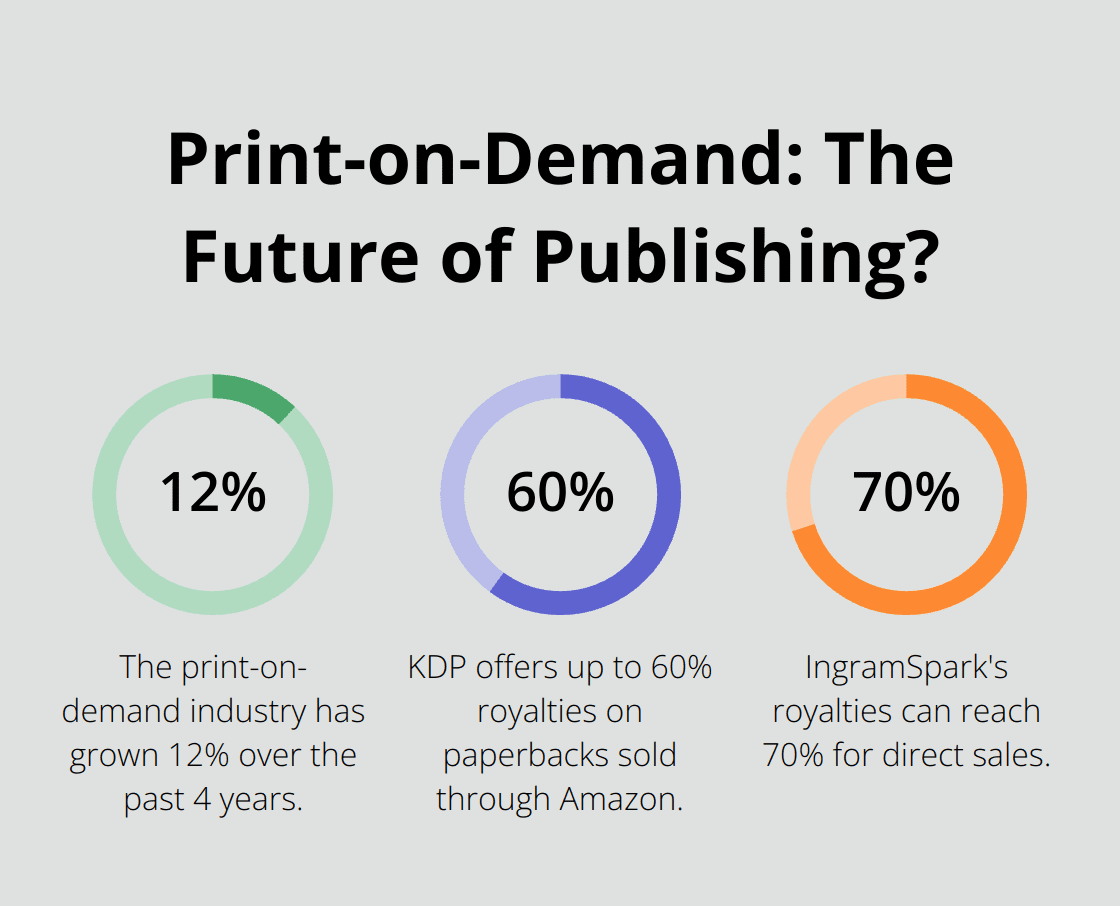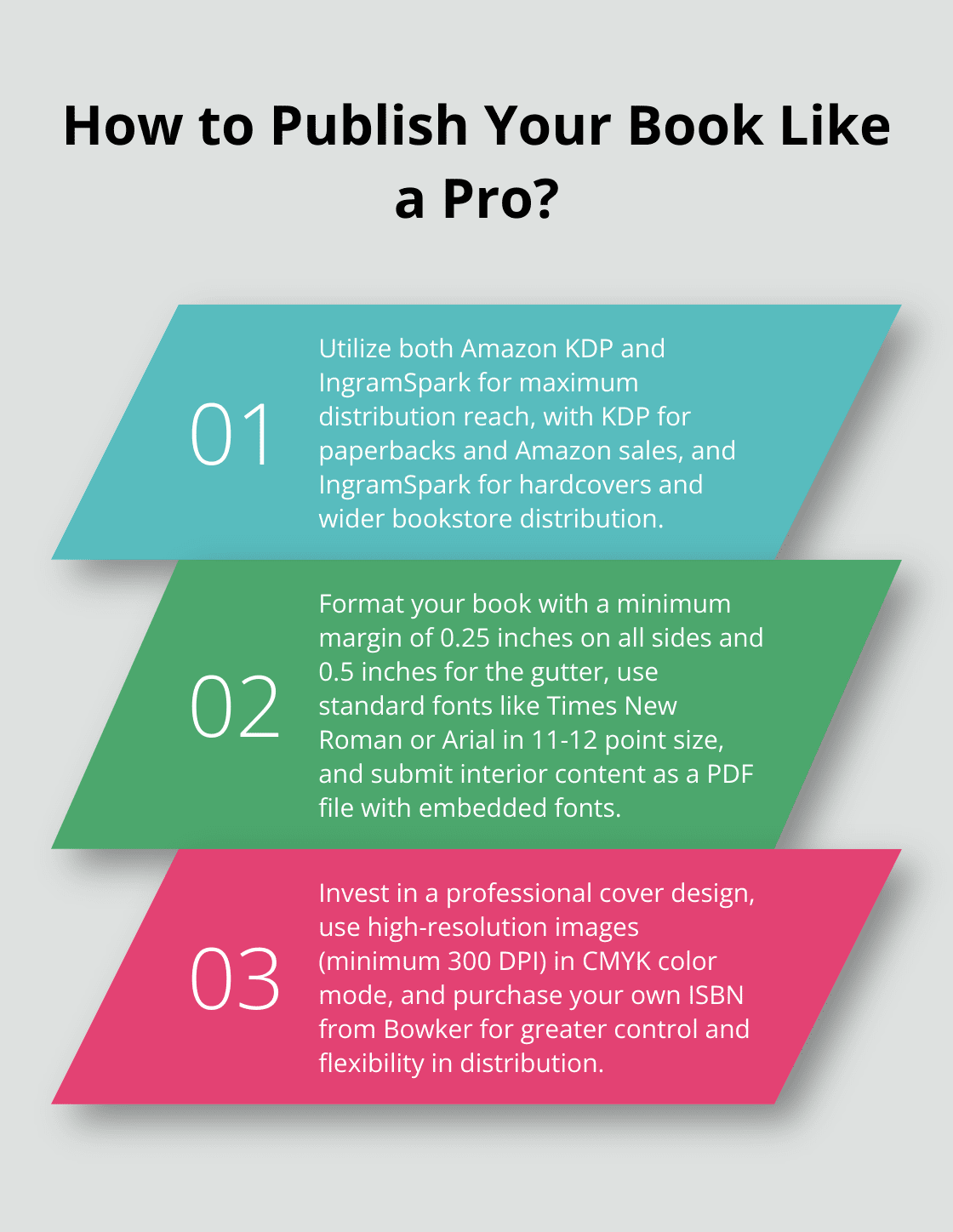Print-on-demand optimization has revolutionized the publishing industry, offering authors unprecedented flexibility and control over their book production.
At Beverly Hills Publishing, we’ve seen firsthand how this technology empowers writers to bring their stories to life without the constraints of traditional printing methods.
In this post, we’ll explore the ins and outs of print-on-demand for books, helping you make informed decisions about your publishing journey.
What is Print-on-Demand for Books?
The Revolutionary POD Technology
Print-on-Demand (POD) has transformed the publishing landscape. This innovative technology allows books to be printed only when an order is placed, eliminating the need for large print runs and warehousing. POD has reshaped how authors and publishers approach book production and distribution.
The POD Process
When a customer orders a book, the POD system activates. The book is printed, bound, and shipped directly to the reader. This process typically completes in just a few days, ensuring quick delivery without extensive inventory management.
Benefits of POD Over Traditional Printing
POD offers several advantages compared to traditional printing methods:
- Reduced upfront costs (no need for large print runs)
- Lower financial risk for new authors
- Easy updates and revisions (particularly useful for non-fiction works)
Print book sales figures have improved and unit sales now consistently surpass 700 million per year. Print also remains the most popular book format. This shift has opened doors for more diverse voices to reach readers.
Major Players in the POD Industry
Several companies dominate the POD landscape:
- Amazon’s Kindle Direct Publishing (KDP): Offers both ebook and print book services
- IngramSpark: Known for its wide distribution network

These platforms have enabled authors to reach global audiences without traditional publishing deals.
The Future of POD
The POD industry continues to evolve. Advancements in printing technology improve quality and reduce costs. As more authors and readers embrace this model, it will likely play an increasingly important role in the future of publishing.
While companies like KDP and IngramSpark offer valuable services, Beverly Hills Publishing™ provides a more comprehensive approach. We combine POD capabilities with strategic branding and marketing, helping authors not just publish, but also establish themselves as industry authorities.
As we explore the intricacies of choosing the right POD service for your book, it’s essential to consider factors beyond just printing capabilities. Let’s examine the key elements that can make or break your POD publishing experience.
Selecting the Best POD Service for Your Book
Distribution Reach: A Key Factor
The distribution network of a Print-on-Demand (POD) service significantly impacts your book’s success. Amazon’s Kindle Direct Publishing (KDP) provides unmatched access to the world’s largest online bookstore. IngramSpark, on the other hand, offers broader distribution to physical bookstores and libraries. Authors who seek maximum reach often use both platforms strategically.
Print Quality and Options Matter
Print quality varies among POD providers. IngramSpark stands out for its high-quality hardcover options, while KDP excels in paperback production. The print-on-demand industry has grown 12% over the past 4 years. A typical self-published, print-on-demand book sells less than 200 physical copies.
Pricing and Royalties: Do the Math
Pricing structures and royalty rates differ significantly between platforms. KDP offers up to 60% royalties on paperbacks sold through Amazon. IngramSpark’s royalties depend on the distribution channel but can reach 70% for direct sales. Authors should calculate potential earnings based on their book’s price point and expected sales channels.
User Experience and Support: Ease of Use Counts
The platform’s ease of use and the quality of customer support can make a significant difference in your publishing experience. KDP boasts a user-friendly interface, while IngramSpark provides more customization options (albeit with a steeper learning curve).
Hidden Costs and Fees: Read the Fine Print
Authors should be aware of additional fees that may not appear obvious at first glance. IngramSpark charges setup fees and revision fees, which can accumulate if you frequently update your book. KDP doesn’t charge these fees but may have higher printing costs for certain book specifications.

While these platforms offer valuable services, Beverly Hills Publishing™ stands out by providing a comprehensive approach that goes beyond just printing. We combine POD capabilities with strategic branding and marketing, helping authors not just publish, but establish themselves as industry authorities.
As you weigh your options, consider how each platform aligns with your overall goals as an author and your book’s specific needs. The right choice depends on your budget, distribution goals, and the level of control you want over the publishing process. Now, let’s explore how to prepare your book for the POD process to ensure the best possible outcome.
How to Prepare Your Book for Print-on-Demand
Print-on-demand (POD) book preparation requires meticulous attention to detail and adherence to specific guidelines. This process ensures your book meets professional standards and industry requirements.
Formatting for POD Success
POD platforms have strict formatting requirements. KDP recommends a minimum margin of 0.25 inches (6.4 mm) on all sides, with 0.5 inches (13 mm) for the gutter margin. Page size must match your chosen trim size exactly. Most POD services prefer PDF files for interior content, with embedded fonts to prevent formatting issues.

Typography impacts readability significantly. Use standard, easily readable fonts like Times New Roman or Arial, typically in 11-12 point size for body text. Line spacing between 1.15 and 1.5 improves readability without wasting space.
Crafting an Eye-Catching Cover
Your book cover serves as your primary marketing tool. Professional design proves worth the investment. POD platforms provide templates based on your chosen trim size, which you must follow precisely. Account for spine width, which varies based on page count.
High-resolution images are essential for POD. Amazon KDP recommends a minimum of 300 DPI for cover images. CMYK color mode is standard for print, so convert your images accordingly.
ISBN and Barcode Requirements
Every print book needs an ISBN (International Standard Book Number). In the U.S., you can purchase ISBNs from Bowker, the official ISBN agency. While some POD services offer free ISBNs, owning your ISBN provides more control and flexibility.
Barcodes hold equal importance. Most POD services generate these automatically based on your ISBN. If you provide your own, ensure it’s in the correct format (typically EAN-13) and placed in the designated area on your back cover.
Quality Control Measures
Proofreading acts as your last line of defense against errors. Professional proofreading services can catch mistakes you might overlook. Tools like Grammarly or ProWritingAid can supplement human proofreading but should not replace it entirely.
Always order proof copies before publishing. This allows you to check physical aspects like paper quality, color accuracy, and binding. Many authors discover issues in print that weren’t apparent on screen.
At Beverly Hills Publishing™, we guide authors through each step of this process, ensuring books meet the highest standards of quality and professionalism. Our expertise in POD optimization (combined with our strategic branding approach) positions your book for maximum impact in the market.
Final Thoughts
Print-on-demand optimization has transformed the publishing industry, giving authors unprecedented control over their work. This technology eliminates large upfront investments and inventory management, allowing writers to focus on creating compelling content. POD provides flexibility for book updates, reduces financial risks, and opens doors for diverse voices to reach global audiences.

The future of POD technology looks promising, with advancements in printing techniques set to deliver higher quality outputs. We expect to see more eco-friendly printing options and increased customization capabilities, which will allow authors to tailor their books to specific reader preferences. AI-driven systems may further streamline the production process, making it even more efficient for authors and publishers alike.
At Beverly Hills Publishing™, we recognize POD’s potential to elevate authors’ careers. We offer a comprehensive approach that combines POD capabilities with strategic branding and marketing. Our goal is to position authors as industry authorities with a commanding media presence. We empower authors to maximize their visibility, build strong brand identities, and achieve lasting success in the competitive publishing world.















































































































































































































































